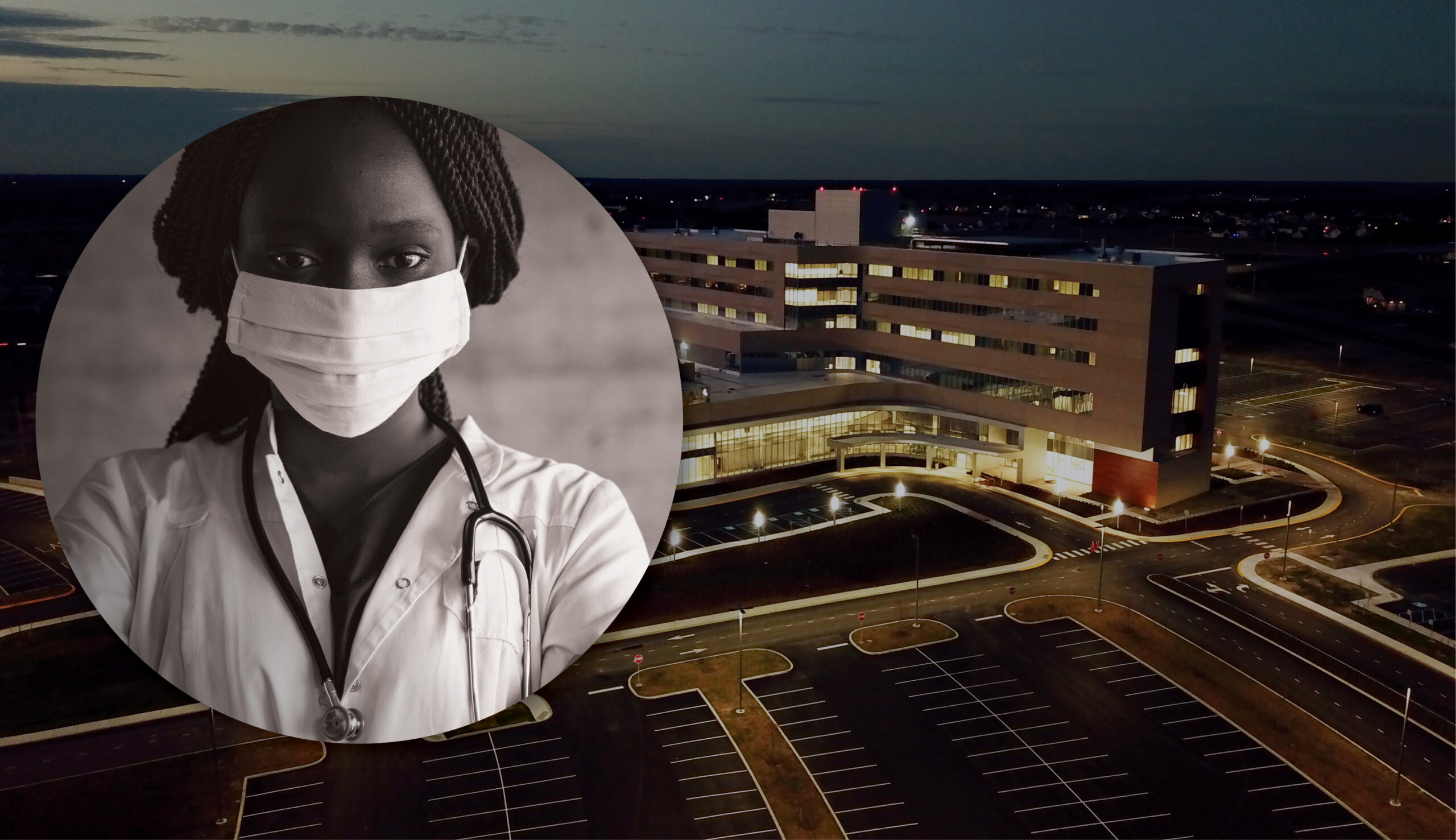COVID-19’s Impact on Hospital Design in Rural America

A Roundtable Discussion with Mike Metzing, Vice President of Corporate Support Services and COVID Incident Commander, Bayhealth; Lou Garzarella, Sr. Director of Facilities Management, Bayhealth; and Brenden Frederick, AIA, LEED AP, Becker Morgan Group
As the COVID-19 pandemic unfolded across the United States, the attention of government agencies, the medical community and the media was on cities with dense populations facing an unprecedented potential for contagion. Yet in rural America, the challenges, while less visible to the public, were equally unprecedented.
Rural Delaware and the Eastern Shores of Maryland and Virginia – known collectively as “Delmarva” – faced many major challenges, but two loomed large. The region’s burgeoning retirement population, which in some areas comprise as much as 20% of the population, was among the most at-risk. Equally threatened were the more than 17,900* employees who work in close proximity to each other in chicken processing plants, many of whom are Hispanic and Haitian and for whom English is not their native language.
While first responders and clinical care staff worked tirelessly on the front lines against COVID-19, facilities managers and staffs in rural hospitals on Delmarva and across the country grappled with unique challenges. This is the story of how Bayhealth Medical Center moved quickly and nimbly in the early days of the pandemic to organize and deploy many systems in new ways. Their creativity saved lives and forever changed how healthcare would be delivered in their system.
Michael Metzing, Vice President of Corporate Support Services and COVID Incident Commander and Lou Garzarella, Senior Director of Facilities Management, both of Bayhealth Medical Center; with architect Brenden Frederick, AIA, LEED AP, from Becker Morgan Group in Salisbury, Md., share some of what they and their teams experienced and learned during the last year.

Mike, what were the main challenges your facilities faced at the onset of COVID-19?
They felt countless, but three core tasks stood out. 1) We had to handle a tremendous influx of patients at the very moment in which we had to begin enforcing social distancing, which made queuing a huge factor; 2) we were faced with increased patient surge capacity, which meant converting non-medical care spaces into temporary holding areas and care structures; and 3) we had to increase amount of outside air and airflow so we could exhaust the space of the potential COVID-19 virus. And we had to do all three at high speed, finding the answers as we went.
Brenden, while Mike was trying to turn the boat at Bayhealth, what were some of the challenges facing architectural professionals working with healthcare clients?
Healthcare clients – especially hospitals – across the rural Mid-Atlantic faced similar situations and I have to say this was a particularly creative time for us. For instance, there were near-immediate shortages of building supplies, so everywhere possible we swapped out materials with substitutions that would not weaken the project at hand. Every solution had to consider how we could keep architects and construction crews safe from COVID-19 while meeting demands of our healthcare frontline workers and the public. We learned a lot.

How did you overcome the challenges you faced?
Mike: There were many things that happened quickly. We built temporary structures in our parking lots to accommodate surge capacity and kept people in their cars until they could be seen to keep our waiting rooms as clear as possible. We utilized plexiglass for solid transparent barriers to reduce the risk of person-to-person transmission.
Brenden: We worked very hard to avoid what I think of as “paralysis of analysis” by brainstorming solutions and testing ideas quickly, developing quick mock-ups to ensure compliance. During this time for example, we renovated a hospital conference center into a COVID-19 surge area for another regional client. Partnering with the client and contractor, we worked together as a team and had the design and construction complete and in service within a month.
Lou, you and Brenden were handling both the creative problem solving and the day-to-day implementation. What makes an effective team in these situations, when there is so much to process in terms of requirements and speed to implementation?
Lou: First, I must acknowledge that we have an excellent Hospital Facilities team. Our people understand our buildings and capabilities because they work there. Literally every day they were called upon to think “out of the box” to solve issues quickly. Sometimes that became ‘try and modify’ on the fly. I often say, “you go to war with what you have,” and we have a high-level team that used its knowledge to adapt and overcome.
Brenden: If I may add, on the architectural side, our focus was on proactivity and process. Architects are always creative, but we had to be even more so in a crisis. There is no ‘up-time,’ so team members must be able to quickly understand how the client sees using a space and then bring all our experience to bear. Our firm handles engineering as well as architecture, and our practice is generalist, so we can often cross-pollinate a solution from another area, such as education or hospitality. We are working on a healthcare project right now for a PACE (property assessed clean energy) program where we are able to integrate the interior design sensibilities from the residential setting into a facility design for daytime senior wellness.

Mike, within your facilities action plan, was there a need for design consultants to work with your team? What were your expectations from your design team partner?
We were fortunate in that Lou’s team includes architects and engineers on staff, so we did not need to engage a firm for our initial COVID-19 response. We held a lot of internal discussions about the facilities and strategic planning with the staff and brainstormed solutions daily.
However, as we make more permanent choices coming out of the pandemic, we plan to partner with consultants such as Becker Morgan Group (with whom we have worked with several times over the last few years.) Becker Morgan is a good example of a partner that shows its value in any number of ways, such as the ability to identify potential issues while offering solutions for consideration. As owners we don’t have time to solve or even identify everything that needs to be considered under more “normal” conditions.
What are the ‘next’ challenges architects and owners will face in this industry? How are you changing your practice to meet them?
Lou: We need to limit touchable surfaces whenever possible. For instance, using windows and doors in patient rooms with the blinds built-in between glass panels. HVAC supply flow and capacity must be able to “flex” general patient rooms to ICU-level care if necessary. Additional technology for video and voice communication to monitor patients remotely is important.
Mike: As Lou said, flexibility is critical. For instance, Central Plants (which runs the complex’s utilities) using manifold systems must allow facilities to run efficiently during standard operation and increase to meet demand with additional units or switching over units when needed. Going forward, facility design must provide additional medical gas and power outlets in patient rooms so we can change single rooms into doubles quickly. Large multipurpose areas such as conference rooms will be designed so they can quickly convert to triage areas.
Brenden: At the heart of architecture, we provide solutions. Until now, we have waited for the client to bring a problem to us. Now there’s an opportunity for design professionals to partner with health care organizations as an R&D “think tank” on topics such as mental health, equitable healthcare and pandemic planning to name a few. Working collaboratively, we can move the needle much more quickly.
Mike, you have been a Health Care facilities director for many years. Were there any leading design or facilities management trends prior to COVID, that should be reconsidered?
Yes, I think so. Tightening up the building from the perspectives of space utilization, energy performance and the reduction of redundancy must be reconsidered because they have resulted in buildings having difficulty being adaptable. For example, COVID increased the demand on hospital HVAC for exhaust and filtration due to increased need in isolation spaces. This became difficult in facilities where there was no additional capacity in the systems to adapt. I hear it again and again from across our facilities: flexibility is the key to future success.
